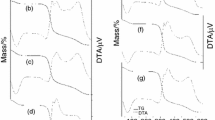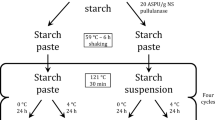Abstract
The effects of gelatinization and gel storage conditions on the formation of canna resistant starch (RS) were investigated. Starch slurries (10%, dwb) were autoclaved at 121 °C for 30, 60, and 120 min. The gels obtained were subsequently stored at different temperatures (4 °C, 30 °C, and 100 °C) and times (0, 1, 3, 5, and 7 days). Analyses of the RS content in gelatinized starch samples in comparison with that in granular starch showed that the RS fraction in granular starch was very high (97.3% w/w); however, nearly all of the RS was thermally unstable, as indicated by a great reduction in RS content (to 1.9% w/w) after cooking at 100 °C for 20 min. The RS contents in gelatinized starch samples were 12.0–15.9% w/w, which were reduced to 7.9–10.8% w/w after cooking. Storage of gels resulted in a significant increase in the amount of the thermally stable RS fraction, e.g., a thermally stable RS content of 16.8% w/w was found in the gel sample gelatinized for 120 min and stored at 4 °C for 3 days. This indicated that the ordered structures of the RS portion were tightened under the storage conditions. The gelatinization temperature of canna starch was 72.2 °C, whereas the RS products exhibited two melting temperature ranges, 51.1–76.3 °C and 163.1–165.1 °C, indicating that the newly formed crystals were very strong.



Similar content being viewed by others
References
Cooke, D., & Gidley, M. J. (1992). Loss of crystalline and molecular order during starch gelatinisation: origin of the enthalpic transition. Carbohydrate Research, 227, 103–112.
Eerlingen, R. C., & Delcour, J. A. (1995). Formation, analysis, structure and properties of type III enzyme resistant starch. Journal of Cereal Science, 22, 129–138.
Eerlingen, R. C., Crombez, M., & Delcour, J. A. (1993). Enzyme-resistant starch: I. Quantitative and qualitative influence of incubation time and temperature of autoclaved starch on resistant starch formation. Cereal Chemistry, 70, 339–344.
Eliasson, A.-C. (1994). Interactions between starch and lipids studied by DSC. Thermochimica Acta, 246, 343–356.
Englyst, H. N., Kingman, S. M., & Cummings, J. H. (1992). Classification and measurement of nutritionally important starch fractions. European Journal of Clinical Nutrition, 46, S33–S50.
Fredriksson, H., Silverio, J., Andersson, R., Eliasson, A.-C., & Aman, P. (1998). The influence of amylose and amylopectin characteristics on gelatinization and retrogradation properties of different starches. Carbohydrate Polymers, 35, 119–134.
Gelencsér, T., Gál, V., Hódsági, M., & Salgó, A. (2008). Evaluation of quality and digestibility characteristics of resistant starch-enriched pasta. Food and Bioprocess Technology, 1, 171–179.
Gelencsér, T., Gál, V., & Salgó, A. (2010). Effects of applied process on the in vitro digestibility and resistant starch content of pasta products. Food and Bioprocess Technology, 3, 491–497.
Gidley, M. J., Cooke, D., Darke, A. H., Hoffmann, R. A., Russell, A. L., & Greenwell, P. (1995). Molecular order and structure in enzyme-resistant retrograded starch. Carbohydrate Polymers, 28, 23–31.
Haralampu, S. G. (2000). Resistant starch—a review of the physical properties and biological impact of RS3. Carbohydrate Polymers, 41, 285–292.
Hung, P., & Morita, N. (2005). Physicochemical properties and enzymatic digestibility of starch from edible canna (Canna edulis) grown in Vietnam. Carbohydrate Polymers, 61, 313–321.
Lehmann, U., Jacobasch, G., & Schmiedl, D. (2002). Characterization of resistant starch type III from banana (Musa acuminata). Journal of Agricultural and Food Chemistry, 50, 5236–5240.
Levine, H., & Slade, L. (1988). Water as a plasticizer: physico-chemical aspects of low-moisture polymeric systems. In F. Franks (Ed.), Water science reviews (Vol. 3, pp. 79–185). Cambridge: Cambridge University Press.
Marsh, R. D. L., & Blanshard, J. M. V. (1988). The application of polymer crystal growth theory to the kinetics of formation of the β-amylose polymorph in a 50% wheat-starch gel. Carbohydrate Polymers, 9, 301–317.
Onyango, C., Bley, T., Jacob, A., Henle, T., & Rohm, H. (2006). Influence of incubation temperature and time on resistant starch type III formation from autoclaved and acid-hydrolysed cassava starch. Carbohydrate Polymers, 66, 494–499.
Puncha-arnon, S., Puttanlek, C., Rungsardthong, V., Pathipanawat, W., & Uttapap, D. (2007). Changes in physicochemical properties and morphology of canna starches during rhizomal development. Carbohydrate Polymers, 70, 206–217.
Ring, S. G., Colonna, P., l’Anson, K. J., Kalichevsky, M. T., Miles, M. J., Morris, V. J., et al. (1987). The gelation and crystallization of amylopectin. Carbohydrate Research, 162, 277–293.
Sajilata, G., Singhal, R. S., & Kulkarni, P. R. (2006). Resistant starch—a review. Comprehensive Reviews in Food Science and Food Safety, 5, 1–17.
Shamai, K., Bianco-Peled, H., & Shimoni, E. (2003). Polymorphism of resistant starch type III. Carbohydrate Polymers, 54(3), 363–369.
Sievert, D., & Wursch, P. (1993). Thermal behavior of potato amylose and enzyme-resistant starch from maize. Cereal Chemistry, 70(3), 333–338.
Silverio, J., Fredriksson, H., Andersson, R., Eliasson, A.-C., & Aman, P. (2000). The effect of temperature cycling on the amylopectin retrogradation of starches with different amylopectin unit-chain length distribution. Carbohydrate Polymers, 42, 175–184.
Slade, L. (1984). Staling of starch-based products. Cereal Foods World, 29, 508.
Srichuwong, S., Sunarti, T. C., Mishima, T., Isono, N., & Hisamatsu, M. (2005). Starches from different botanical sources—I: contribution of amylopectin fine structure to thermal properties and enzyme digestibility. Carbohydrate Polymers, 60(4), 529–538.
Thitipraphunkul, K., Uttapap, D., Piyachomkwan, K. A., & Takeda, Y. (2003a). A comparative study of edible canna (Canna edulis) starch from different cultivars—part I: chemical composition and physicochemical properties. Carbohydrate Polymers, 53, 317–324.
Thitipraphunkul, K., Uttapap, D., Piyachomkwan, K. A., & Takeda, Y. (2003b). A comparative study of edible canna (Canna edulis) starch from different cultivars—part II: molecular structure of amylose and amylopectin. Carbohydrate Polymers, 54, 489–498.
Wang, J., Jin, Z., & Yuan, X. (2007). Preparation of resistant starch from starch–guar gum extrudates and their properties. Food Chemistry, 101, 20–25.
Watcharatewinkul, Y., Uttapap, D., Puttanlek, C., & Rungsardthong, V. (2010). Enzyme digestibility and acid/shear stability of heat-moisture treated canna starch. Starch/Starke, 62, 205–216.
Xie, F., Dowell, F. E., & Sun, X. S. (2004). Using visible and near-infrared reflectance spectroscopy and differential scanning calorimetry to study starch, protein, and temperature effects on bread staling. Cereal Chemistry, 81(2), 249–254.
Yuan, R. C., Thompson, D. B., & Boyer, C. D. (1993). Fine structure of amylopectin in relation to gelatinization and retrogradation behavior of maize starches from three wx-containing genotypes in two inbred lines. Cereal Chemistry, 70(1), 81–89.
Zaidul, I. S. M., Absar, N., Kim, S.-J., Suzuki, T., Karim, A. A., Yamauchi, H., et al. (2008). DSC study of mixtures of wheat flour and potato, sweet potato, cassava, and yam starches. Journal of Food Engineering, 86, 68–73.
Acknowledgments
We gratefully acknowledge grants from the Thailand Research Fund under TRF-MAG Project MRG-WII515S078 and the Commission on Higher Education, Thailand under KMUTT National University Research Project.
Author information
Authors and Affiliations
Corresponding author
Rights and permissions
About this article
Cite this article
Wandee, Y., Puttanlek, C., Rungsardthong, V. et al. Effects of Gelatinization and Gel Storage Conditions on the Formation of Canna Resistant Starch. Food Bioprocess Technol 5, 2665–2673 (2012). https://doi.org/10.1007/s11947-011-0629-0
Received:
Accepted:
Published:
Issue Date:
DOI: https://doi.org/10.1007/s11947-011-0629-0




